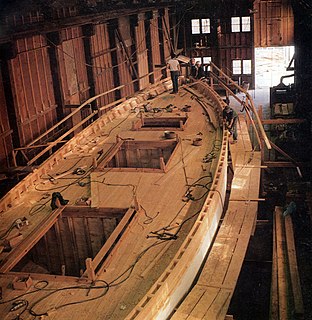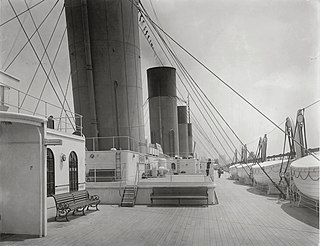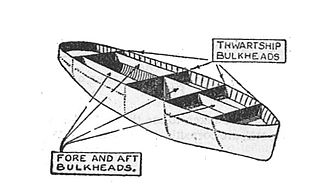
A hull is the watertight body of a ship, boat, or flying boat. The hull may open at the top, or it may be fully or partially covered with a deck. Atop the deck may be a deckhouse and other superstructures, such as a funnel, derrick, or mast. The line where the hull meets the water surface is called the waterline.

A broadside is the side of a ship, or more specifically the battery of cannon on one side of a warship or their coordinated fire in naval warfare, or a measurement of a warship's maximum simultaneous firepower which can be delivered upon a single target. From the 16th century until the early decades of the steamship, vessels had rows of guns set in each side of the hull. Firing all guns on one side of the ship became known as a "broadside". The cannon of 18th-century men of war were accurate only at short range, and their penetrating power mediocre, which meant that the thick hulls of wooden ships could only be pierced at short ranges. These wooden ships sailed closer and closer towards each other until cannon fire would be effective. Each tried to be the first to fire a broadside, often giving one party a decisive headstart in the battle when it crippled the other ship.

Boat building is the design and construction of boats and their systems. This includes at a minimum a hull, with propulsion, mechanical, navigation, safety and other systems as a craft requires.

A cutter is a type of watercraft. The term has several meanings. It can apply to the rig of a sailing vessel, to a governmental enforcement agency vessel, to a type of ship's boat which can be used under sail or oars, or, historically, to a type of fast-sailing vessel introduced in the 18th century, some of which were used as small warships.

A fishing trawler is a commercial fishing vessel designed to operate fishing trawls. Trawling is a method of fishing that involves actively dragging or pulling a trawl through the water behind one or more trawlers. Trawls are fishing nets that are pulled along the bottom of the sea or in midwater at a specified depth. A trawler may also operate two or more trawl nets simultaneously.

A deck is a permanent covering over a compartment or a hull of a ship. On a boat or ship, the primary or upper deck is the horizontal structure that forms the "roof" of the hull, strengthening it and serving as the primary working surface. Vessels often have more than one level both within the hull and in the superstructure above the primary deck, similar to the floors of a multi-storey building, that are also referred to as decks, as are certain compartments and decks built over specific areas of the superstructure. Decks for some purposes have specific names.
This is a glossary of nautical terms; some remain current, while many date from the 17th to 19th centuries. See also Wiktionary's nautical terms, Category:Nautical terms, and Nautical metaphors in English. See the Further reading section for additional words and references.

The bow is the forward part of the hull of a ship or boat, the point that is usually most forward when the vessel is underway. The aft end of the boat is the stern.

The Caldwell class was a class of six "flush deck" United States Navy destroyers built during World War I and shortly after. Four served as convoy escorts in the Atlantic; the other two were completed too late for wartime service. Two were scrapped during the 1930s, but four survived to serve throughout World War II, three of these in service with the Royal Navy under the Destroyers for Bases Agreement and the fourth as a high speed transport.

Floodability is the susceptibility of a ship's construction to flooding. It also refers to the ability to intentionally flood certain areas of the hull for damage control purposes, or to increase stability, which is particularly important in combat vessels, which often face the possibility of serious hull breach due to enemy action, and which rely on well-trained damage controlmen to equalize and then stop flooding of the hull.

The Sovetsky Soyuz-class battleships, also known as "Stalin's Republics", were a class of battleships begun by the Soviet Union in the late 1930s but never brought into service. They were designed in response to the Bismarck-class battleships being built by Germany. Only four hulls of the fifteen originally planned had been laid down by 1940, when the decision was made to cut the program to only three ships to divert resources to an expanded army rearmament program.

The Stalingrad-class battlecruiser, also known as Project 82, was a Soviet battlecruiser design from 1941. It was a smaller and less-expensive counterpart to the Kronshtadt-class battlecruisers of 1939. The original role was for a light, fast ship intended to break up attacks by British fast-cruiser forces that might attempt bombardment of Russia's northern ports. In keeping with the battlecruiser design concept, they would have been able to outgun any ship with similar speed, or outrun anything more heavily armed. Design work had just started when the German invasion of the Soviet Union opened and the design was put on hold.

The Lyon class was a set of battleships planned for the French Navy in 1913, with construction scheduled to begin in 1915. The class was to have comprised four ships, named Lyon, Lille, Duquesne, and Tourville. The first two were named for cities in France, and the latter pair honored the French admirals Abraham Duquesne and Anne Hilarion de Tourville. The Lyon class' design was an improvement on the previous Normandie class, utilizing a fourth quadruple-gun turret to mount a total of sixteen 34 cm (13.4 in) guns. Construction on the Lyons was cancelled due to the August 1914 outbreak of World War I, before any of the ships were laid down.

The draft or draught of a ship's hull is the vertical distance between the waterline and the bottom of the hull (keel). The draught of the vessel is the maximum depth of any part of the vessel, including appendages such as rudders, propellers and drop keels if deployed. Draft determines the minimum depth of water a ship or boat can safely navigate. The related term air draft is the maximum height of any part of the vessel above the water.

A whaleback was a type of cargo steamship of unusual design, with a hull that continuously curved above the waterline from vertical to horizontal. When fully loaded, only the rounded portion of the hull could be seen above the waterline. With sides curved in towards the ends, it had a spoon bow and a very convex upper deck. It was formerly used on the Great Lakes of Canada and the United States, notably for carrying grain or ore. The sole surviving ship of the "whaleback" design is the SS Meteor, which is docked in Superior, Wisconsin as a museum ship.

In traditional nautical use, well decks were decks lower than decks fore and aft, usually at the main deck level, so that breaks appear in the main deck profile, as opposed to a flush deck profile. The term goes back to the days of sail. Late-20th-century commercial and military amphibious ships have applied the term to an entirely different type of hangar-like structure, evolving from exaggerated deep "well decks" of World War II amphibious vessels, that can be flooded for lighters or landing craft.

SS Ste. Claire is a steamer located in Detroit, Michigan. Built in 1910, she was one of the last propeller-driven excursion steamers to be operated on the Great Lakes. She was declared a US National Historic Landmark in 1992. In 2018, a devastating fire destroyed the upper decks, leaving only the steel structure.

The Sparrow-Hawk was a 'small pinnace' similar to the full-rigged pinnace Virginia that sailed for the English Colonies in June 1626. She is the earliest ship to participate in the first decades of English settlement in the New World to have survived to the present day.


















